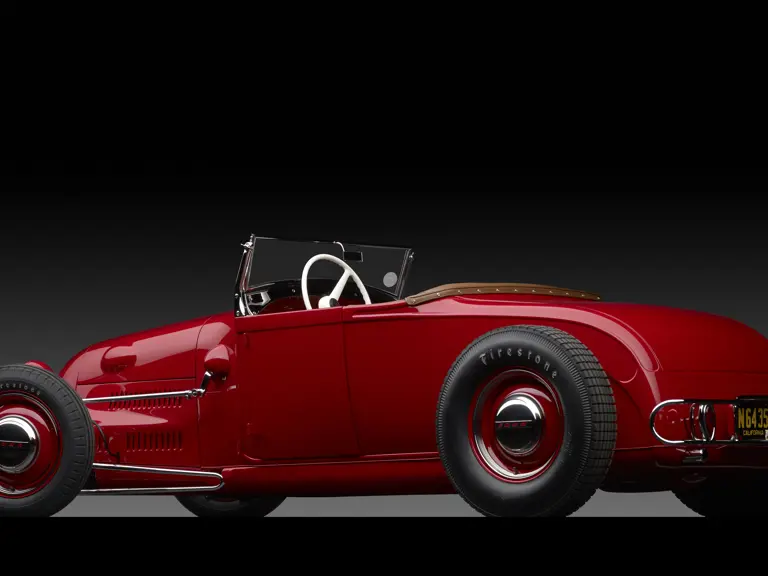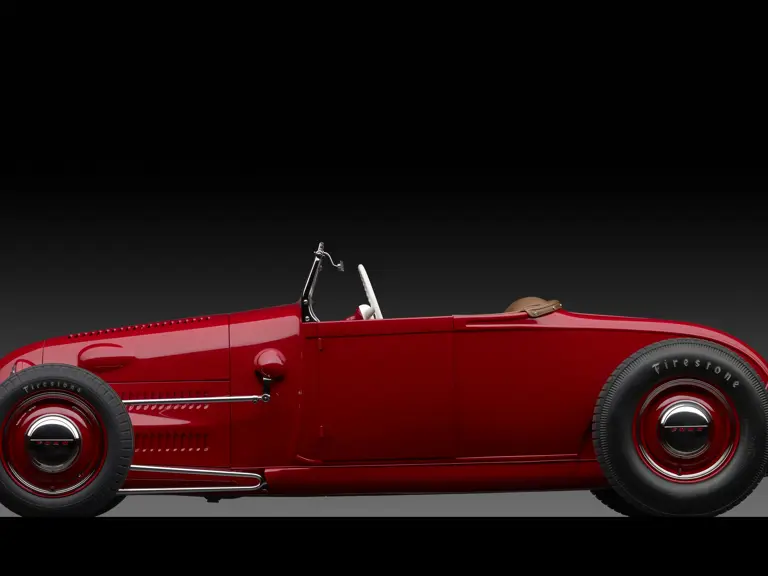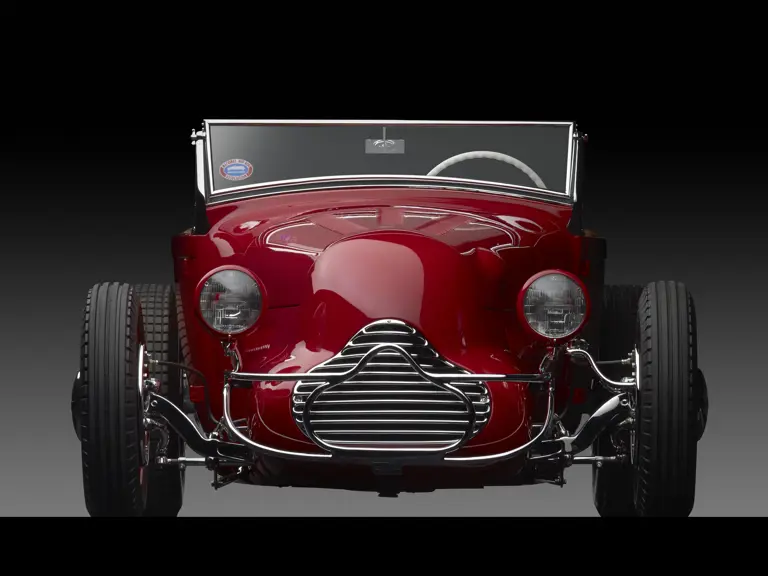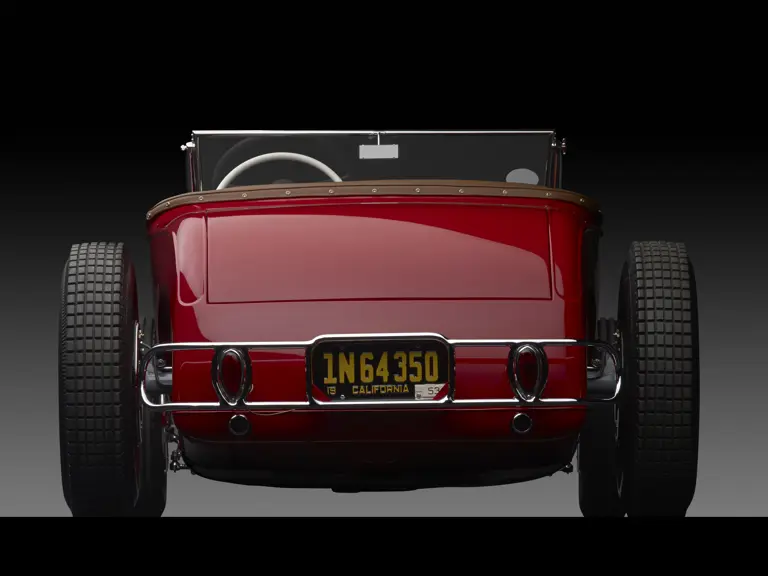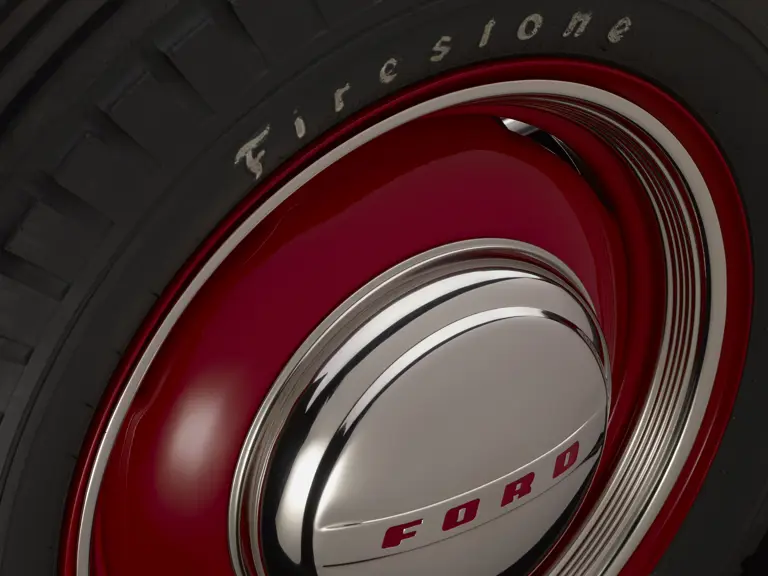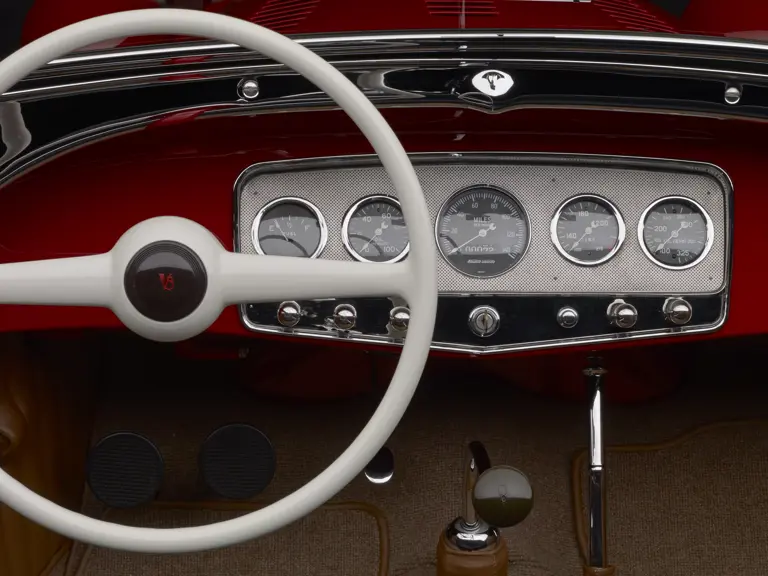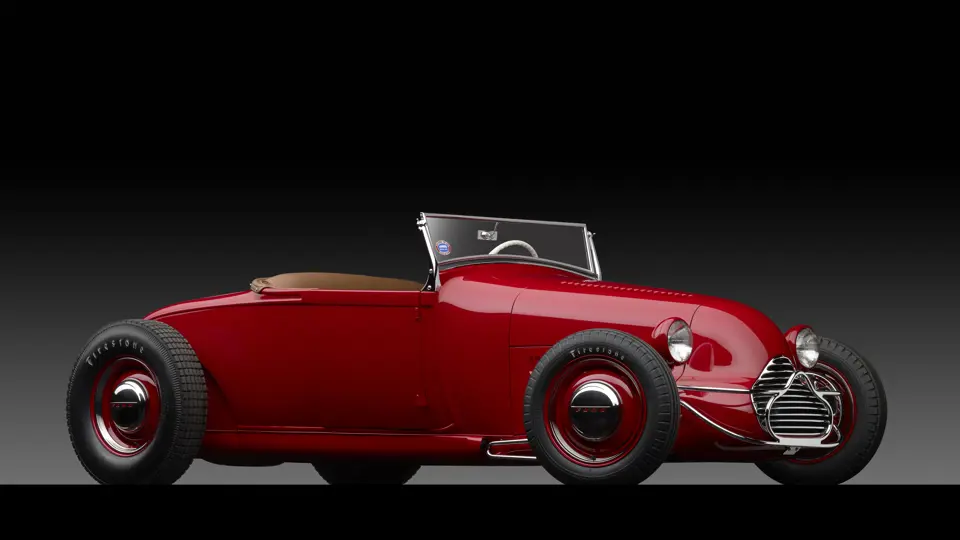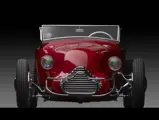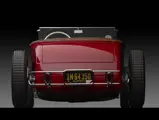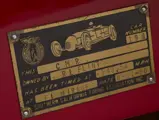 | New York, New York
| New York, New York
Dick Flint and a friend stop at a crosswalk, watching a voluptuous coed pass in front of them. Dick's friend leaps out of the car as her eyes turn to the boys’ arresting red Roadster.
This was the iconic scene captured on the cover of the May 1952 issue of Hot Rod Magazine. The magazine’s founder, the late Robert E. Petersen, remembered it as “the first issue where we sold over half a million copies.” Thousands of men, then young and now young at heart, recall that moment: those perfect proportions, that sleek race car-inspired nose, those ’39 teardrop taillights, the Auburn dash panel, and those neat custom nerf bars!
The “Dick Flint” Roadster is an icon, not just to car guys, but also to an era of men whose imaginations it set afire.
THE DICK FLINT ROADSTER
Dick Flint’s V-8 was the “Hot Rod of the Month” in the May 1952 Hot Rod, where it was capped with a full photo shoot by Felix Zelenka and a Rex Burnett cutaway drawing. The car’s contours were perfect, and its functional belly pan was beyond the capability of the average mid-century rodder. The hand-formed aluminum pan was done by Valley Custom’s Neil Emory and Clay Jensen and hot rod racer and noted author Dean Bachelor, who eventually became the editor of Road & Track. The Valley Custom Shop also fabricated the sleek nose and hood, complete with inverse louvers and a smooth, generator-clearing side blister. And that notable nose wasn’t just a pretty face: Dick Flint turned an impressive 143.54 mph in this car at El Mirage in 1950.
Flint had begun with three Model A Roadster bodies, salvaging the best parts of each one to assemble a sound example. Then he channeled the body over a Model A frame. Flint built the brackets that held the body to the chassis, and he also made the engine mounts, shock brackets, the nerf bars, and every fixture needed to mount the battery, exhaust system, and the fuel tank. He then adapted hydraulic brakes from a ’46 Ford and fitted a So-Cal dropped and filled front axle. Next, Flint brought the “roller” to Valley Custom for extensive bodywork, while he began building the engine.
Working with Neil Emory, and with advice from Dean Batchelor, Flint envisioned a wind-cheating track nose that was reminiscent of those on pre-war Indy race cars. As was so often done, Dick and Neil chalked out the shape of the nose on the shop floor. Using 18 pieces of welding rod, partners Emory and Jensen developed a supporting framework, and then they hand-formed the lovely nose section out of aluminum. Emory also made the grille out of round aluminum rod. Flint filed it to perfection before it was buffed, and it was clear lacquered to protect the finish. They also fabricated the shapely three-piece hood and took it to Art Engles, who punched the louvers from the outside in.
Valley Custom did a great deal of custom bodywork on this car. The seams under the decklid were filled, the side panels were flared inward, and the rear deck corner reveals were finished to look like those of a ’32 Ford. The panels in the wheel wells had rusted out, so Valley Custom replaced them with new removable panels. The full belly pan was made up in five pieces, which could be easily removed to service chassis components.
To complete the car’s smooth appearance, Valley Custom welded and filled the joint where the Model A cowl met the body. The hole in the cowl for the original Model A fuel tank was filled, and a new tank was relocated under the decklid. Inside, a ’32 Auburn dash panel was carefully made to fit and inset with an Auburn instrument panel. Original convex-lensed winged Stewart-Warner instruments replaced the original Auburn gauges (also made by S-W), and two additional gauges, a fuel pressure gauge, and an ammeter flank the panel. Flint retained the Auburn’s original 100-mph speedometer. He trimmed the fluting off an Art Deco ’40 Ford wheel, cut down a ’39 floorshift handle for the transmission, which was fitted with a 26-tooth close-ratio Zephyr cluster, and retained Floyd Tipton, in Burbank, to upholster the car in medium brown co-hide, which was a natural-appearing synthetic leather.
While Valley Custom’s crew completed the body work, Flint began on the ’40 Mercury flathead. Displacement was 286 cubic inches. Flint installed one of the hot sticks of the 1940s: a Winfield Super 1A camshaft. The usual internal mods were performed, including Johnson adjustable tappets, three-ring racing pistons, and a full balancing of the internal moving parts, plus a port, polish, and relief job. The ignition was built by Dick’s friend, Karl Fleischmann. It was fitted with three Stromberg 97 carburetors on an Edelbrock intake manifold that had matching block-letter Edelbrock 9:1 high-compression heads. Tubular headers, with discretely hidden lakes plugs, rounded out the externals. In stark contrast to the car, the original engine finish wasn’t particularly pretty. Both top radiator hoses had to be routed sideways to clear the generator and belt pulleys. But, in this case, looks didn’t matter. In the lower corner of the dash is an SCTA timing tag, attesting to an El Mirage run of 143.54 mph. That mattered.
Interestingly, dry lakes enthusiast Dick Saillant photographed this car at a Russetta Timing Association meet in 1951. Following a practice done by top shops today, Flint assembled the entire car and then ran it at the lakes in both RTA and SCTA meets, before disassembling it for plating and paint. The fully completed ’29 was initially featured in the November 1951 issue of the original Hop Up, and again as a cover car for a larger article in Hop Up (which had transitioned from a pocket magazine to a full-sized one) in May 1953. It represented the fledgling NHRA at several shows, and it won awards at the Oakland Roadster Show and the third Los Angeles Motorama. It is strongly believed that the Roadster depicted on the initial NHRA membership badge was the Dick Flint ’29.
The final finish was Federal Truck Red. The car was featured with whitewalls and fake wire wheel caps on the ’53 Hop Up cover. Dean Batchelor recounts that they temporarily installed whitewalls on the right side of the car to brighten up the cover shot. The Halibrand Quickchange, with a 3.27:1 ratio, and relocated Ross steering, with that distinctive high-mounted drag link, were later additions.
Dick Flint owned the Roadster until 1961. In those days, Hot Rod magazine had a classifieds section, and the car was actually offered for sale! Duane Kofoed, a member of the LA Roadsters, acquired the Dick Flint Roadster in the early 1960s. He drove it extensively, and it was photographed and filmed at many shows and rod runs.
HOT RODDING ON A NATIONAL STAGE
Fast forward some 30 years. Don Orosco, of Pebble Beach, an enthusiastic vintage racer and hot rodder, had been trying to purchase a historic ’32 Ford Roadster. On a tip from Neal East, Orosco contacted Kofoed, who was at first reluctant to sell; in fact, it took Duane two years before he even consented to send Don photos of the car. Orosco knew exactly what it was, of course, and after an inspection meeting at Duane’s home in Burbank, Don immediately acquired the car.
Orosco and his talented crew studied the old car to see what had been done to it over the years, and they thought about what they could do to it. They finally decided to re-engineer the frame and build an entirely new platform for the car, using only construction techniques and materials that were available from 1950–1951.
The resulting chassis was fabricated, beginning with an extensively cut-down ’32 Ford K-member (actually disassembled at first into 25 pieces) that was mated to an original Model A frame. The new frame was zee-ed at either end and extensively boxed, with the lightening holes cut and flared over as though they’d originally been done by the Ford factory. Incredibly, a Model A firewall was carefully trimmed down to fit the new height requirements, and it was also finished to fit as a factory part. Steel tubing was used to stabilize the cowl section and cradle the Willys-Knight steering box, as was fifties-era race car practice.
The team closely copied Ford factory welding style, frame rail forming, and riveting practice. The resulting new frame was strong, beautiful, and functional. Don Orosco says that it would have been cheaper to build the car from scratch than it was to sensitively restore it. Dick Flint says that the final result was absolutely necessary, adding, “…it was the way I would have done it if I had the resources, and if I could have done it over.”
The Roadster made its debut at the 50th Anniversary Oakland Roadster Show in 1999. Dick Flint and some of the original Sidewinders were there to see it. Fittingly, the ’29 received a great deal of critical acclaim. Still, a few details needed correction. Don and his team had fabricated the hood and incorporated a top bubble, which cleared the carburetors and air cleaners. That wasn’t the way Flint built the car, so they redid the hood accordingly. The upholstery was redone again, this time by acclaimed upholsterer Tom Sewell, and it utilized a leatherette that more closely resembled the grained original material. Orosco had managed to locate an NOS set of Firestone block tread Ascot tires, at a “huge” expense, from a man in Southern California, who’d been hoarding them for years. “In the end,” he reflects, “the cost of this restoration didn’t matter. We were dead-set on getting it right for future generations to admire. We were striving for perfection.”
The Dick Flint ’29 was one of nine Roadsters present for the second hot rod class at the Pebble Beach Concours d’Elegance in 2001. The hot rod display was simply terrific. Parked in a long parallel row, the lineup of nine multihued, impudent Ts, As, and Deuces was a wonderful contrast to the more formal classics and swoopy sports cars. At the end of the day, Don Orosco and Dick Flint were happy to receive First Place, along with the Dean Batchelor Memorial Trophy, which was named for one of the men who had worked on this car in 1952.
In 2000, Orosco was invited by the Earl of March to participate in the Goodwood Festival of Speed in England, and he enthusiastically blasted his way up the tricky hill climb course that is euphemistically known as “Lord March’s driveway.”
Built at a time when hot rodding was the purest and most American of arts, the Dick Flint Roadster is now offered here, in the next step of a fascinating story, as one of the most important of all surviving vintage hot rods. Considered one of the best hot rods ever, it is the cornerstone upon which so many Roadsters have been built over the last half century, and it is an inimitable piece of motoring history.





